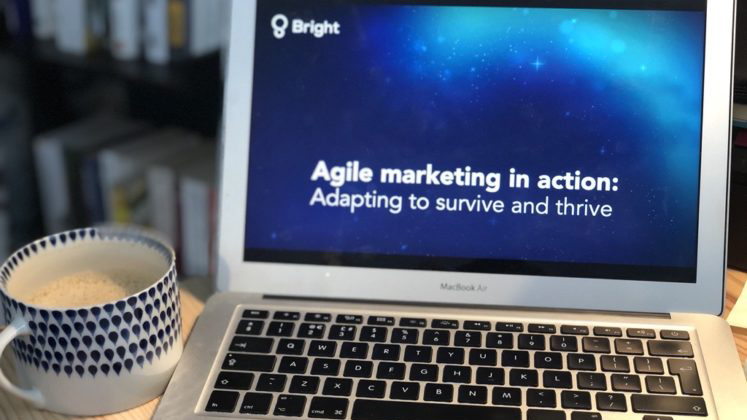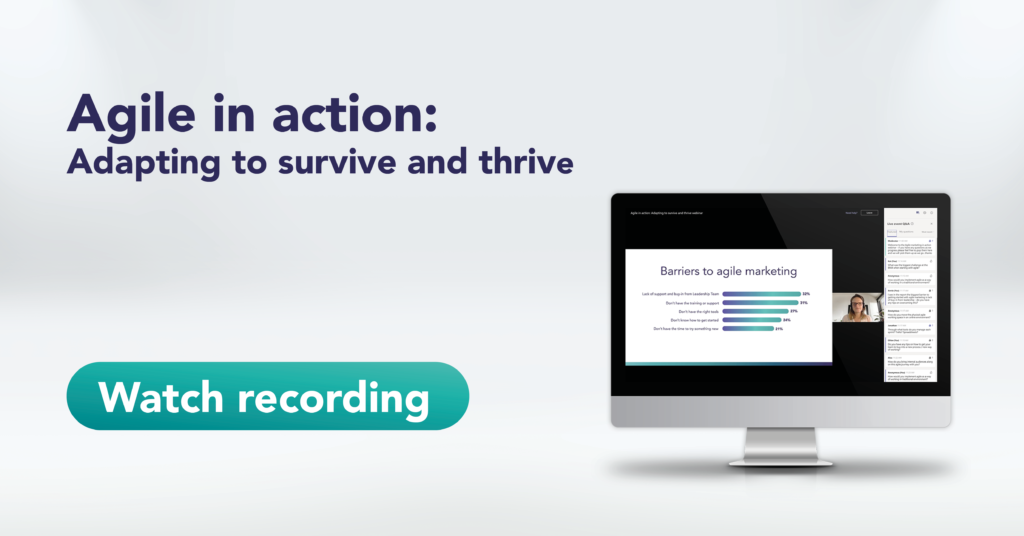The Bright webinar, Agile marketing in action: Adapting to survive and thrive, went live on Wednesday, 29 April, 11am and safe to say we loved the experience! The virtual event attracted marketing professionals across a diverse range of industries, and it was a brilliant opportunity for us to drive the conversation on all things agile.
So, What is Agile Marketing?
The session kicked off, after brief introductions to speakers, by defining the term agile, exploring the success of agility in a broader sense in relation to efficiency, pace, innovation, and reduction of issues and risks. Three core values and principles from the original manifesto were then drawn upon in more detail:
- Customer focus – spotlight on the buyer journey and how to engage and interact along the way
- Experimentation – using a test, learn, iterate approach to generate data-driven insights and results
- Minimal viable approach – using short, adaptive strategies to demonstrate success
Given the current circumstances affecting businesses across the globe, it was important to mention the COVID-19 outbreak to set context and avoid the overused term ‘unprecedented circumstances’, from dominating the conversation. To do so, we explored why agile marketing is no longer a nicety but now business critical and how this ability to adapt to market disruption is crucial for companies of all shapes and sizes.
We also discussed the challenges our clients and most other marketers are having to deal with at the moment, including frozen budgets, organisational paralysis and poor change management. That said, we are starting to see the most forward-thinking firms focus their attention on lead generation and client retention activities to ensure pipelines don’t fall off a cliff. This means they can build momentum and new business to safeguard their businesses and meet revised sales targets for later this year.
Sian Heaphy, Agile Lead at Bright shared the results of our recent Future of B2B Marketing Report diving into the detail of the survey we undertook and its key findings as well as exploring what these insights actually mean for marketers now. Summing up with the benefits of agile marketing supported by the survey findings and the long-term, tangible benefits we uncovered for teams that adopt an agile way of working.
“It’s given teams greater flexibility, transparency and control over their project tasks. They’re more empowered to collaborate, experiment and react quickly to change when their ideas are validated through the test, learn and iterate approach, critical success factors for resilience.” – Sian Heaphy
Next, Adrian Brooks, Change Lead at British Medical Association (BMA) talked about his experience of introducing agile marketing to take a new proposition to market. This lively discussion detailed the BMA’s journey to inject agility and pace into their marketing practices, barriers to adoption (and how they overcame them) and the results and long-term benefits achieved through the adoption of agile marketing.
The session ended with an interactive Q&A, with Adrian and Sian fielding questions from the audience. There were lots of thought-provoking questions we didn’t have time to cover so we’ve created a complete Q&A below for reference.
Q&A
How would you implement agile as a way of working in a traditional environment?
The key is to start small. You aren’t going to become an agile marketing team overnight. Find a pilot project (proposition development and / or go to market campaigns work really well for a pilot) where you can test a hypothesis using new ways of working.
Work with an experienced partner (like Bright) and select a handful of your team to work on the pilot and establish an agile marketing hub (3-5 members is a good number) and get them bought into the vision and what you’re trying to achieve. Give them the support and resource they need to run the pilot independently from other activity, taking into account any BAU work they are responsible for.
I see in the research and the Future of Marketing Report the biggest barrier to getting started with agile marketing is lack of buy-in from leadership – do you have any tips on overcoming this?
At BMA we were lucky that at a project level, the leadership team was very supportive. We were working on a new proposition targeting a new market so from the get-go the project ethos was to be different and try new things. There was some resistance within the senior leadership due to the new ways of working suggested so we had to build the business case and confidence for this. Demonstrating why being agile and adaptable would help us get better results and help the in-house team get experience.
BMA had a multi-pronged stakeholder management approach – engaging with the members, steering committee and senior management at a formal level and at a 1:1 level with key people. Regular reporting and transparency on project progress was really critical to generating their buy-in. Agile focus on data and the ability to provide them with insight at every stage to demonstrate the learnings and value we were generating on a week by week basis was invaluable to getting engagement and buy-in.
What tools do you manage each sprint?
Tooling is a question we see a lot, and it was one of the biggest barriers to adopting agile marketing identified in our survey.
From a project management perspective, there are a number of ways to get started. Trello is a great tool to get started with to build a simple Kanban board that you can use to create your sprint backlog and monitor progress throughout the sprint.
For a lot of our projects we use Monday.com which offers the same benefits as Trello but is a much more robust project management tool where everyone can easily understand status and priorities. It’s also accessible anywhere by the team which has been important as project team hubs are working remotely.
From a physical perspective at its simplest, creating a workspace in your office where you can create a Kanban board using a white board or post-it notes can be just as effective. In the current climate this isn’t possible, but it can be a great way of bringing the team together in one area to collaborate.
The key to successful sprint management is to make sure that whatever tool or mechanism you’re using to track sprints is being utilised by the team, so you get the visibility you need to understand progress.
Collaboration tools are also key for successful agile hub and management whether you’re using Microsoft Teams, Slack, Skype or any other communication tools, creating a virtual area where team members can interact, collaborate and communicate is critical.
We also use Mural for many virtual creative ideation sessions and to capture retrospectives at the close of each sprint.
Did your sprint targets vary or were they quite consistent over time? How many targets were identified for each sprint?
The short answer is yes. It’s important to create an overarching goal or KPIs for the project or campaign as a whole and then break it down into specific goals or KPIs for each sprint that will move you towards achieving the project goal.
The great thing about agile ways of working is that it’s data-driven, so you can regularly review your metrics and update and change as you progress. It’s about finding what works and optimising to help you achieve your goal(s).
Culture – I find that is the major challenge, genuinely the hardest piece. Any suggestions? How do you get people to buy into the process?
At BMA, they had a very traditional ways of working with siloed teams, so breaking down that culture was really difficult. It was the biggest challenge/barrier to success. We had really fixed ways of working. One of the ways that we started to break this down was to bring managers into the agile hub so we could talk about the process and resources required in real terms. What was needed at each stage and who would be responsible for it. And giving managers that clarity on how the different elements worked together really helped to break down these ingrained ways of working.
Communication is really important and giving members of the team clear roles and autonomy over their tasks is really powerful, empowering the teams to make their own decisions. With any change you’ll find members of the team who are open to it (and can become great ambassadors for these new ways of working) and others who see it as a threat. Communicate the vision, what you’re trying to achieve and what role they can play in delivering that (and provide the training and support needed to help them) is a great way to start bringing them on that journey.
If you missed our webinar but like the sound of what you’re reading, fear not, as the recording is now available! View the Agile in Action: Adapting to Survive and Thrive webinar today, join our Agile Marketing Club Meet Up group and keep an eye on our social channels for announcements of the next webinar, coming soon to a home-office near you!


